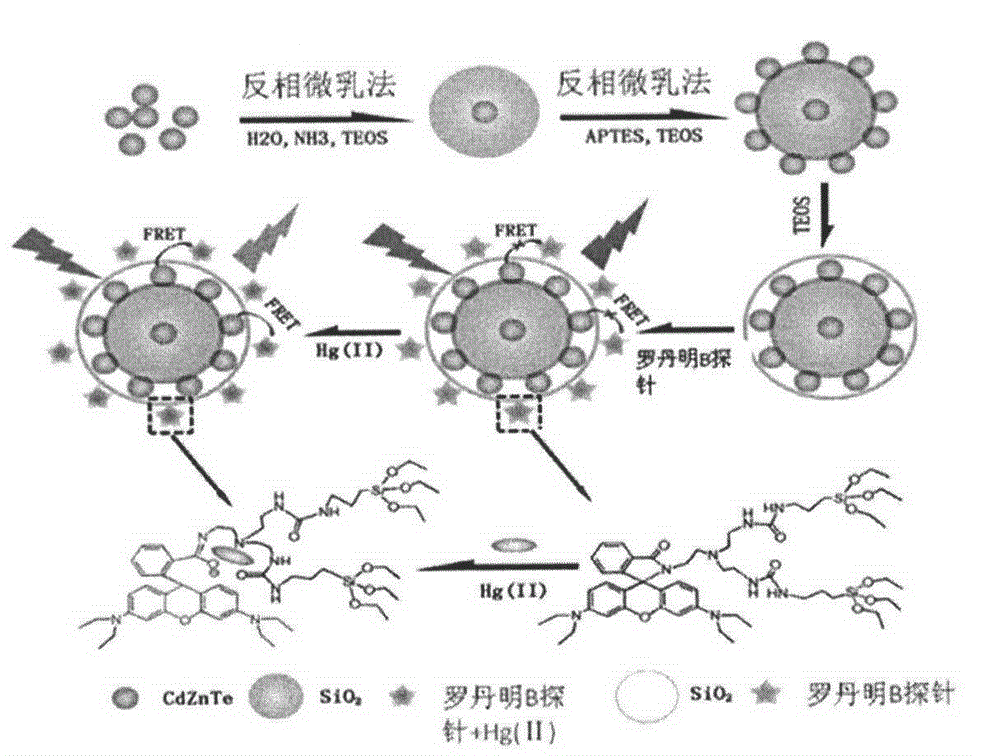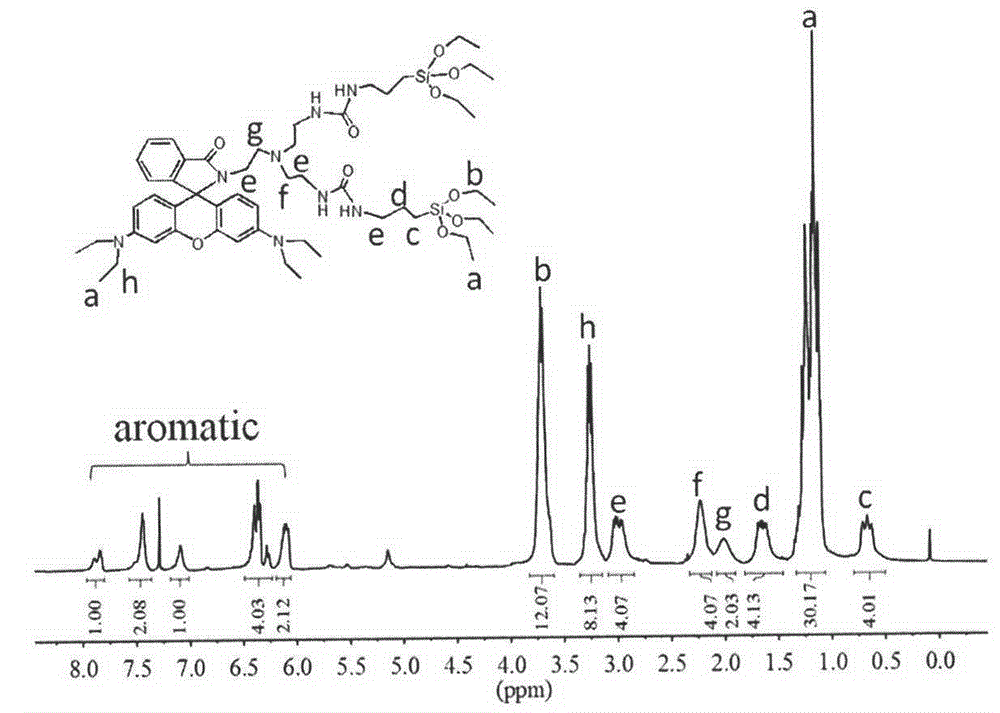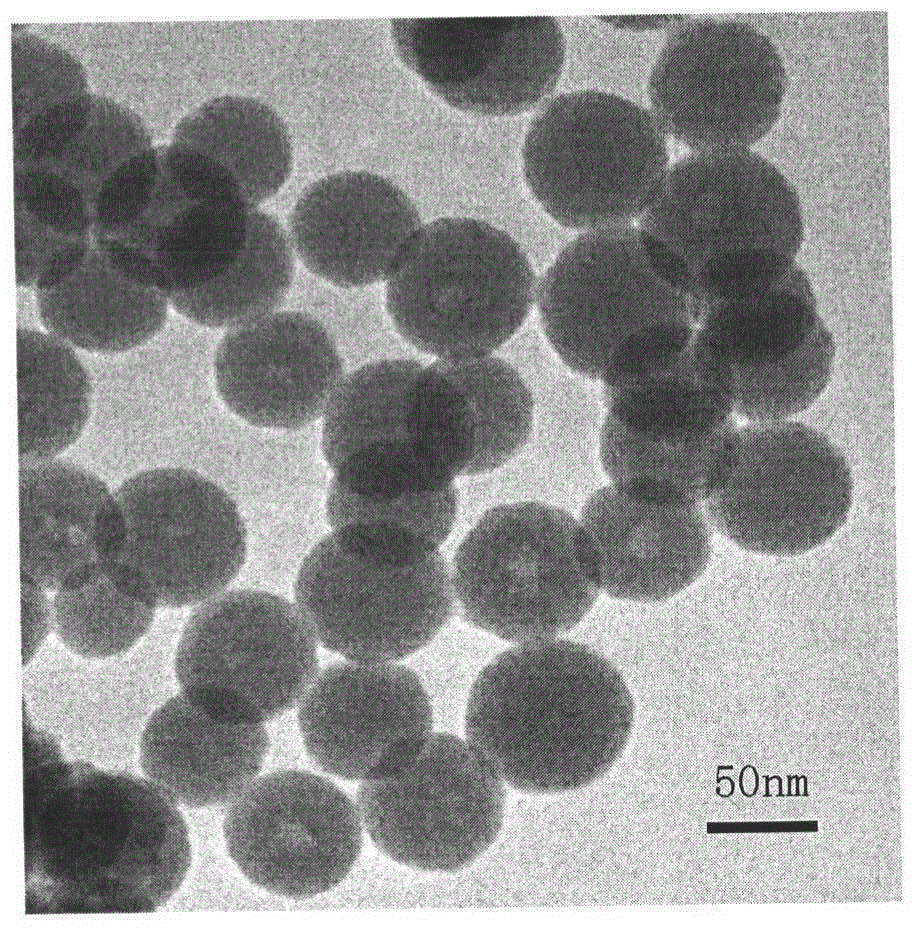Preparation method of mercury ion rate probe based on rhodamine derivative and quantum dot fluorescent microsphere
A technology of fluorescent microspheres and derivatives, which is applied in chemical instruments and methods, fluorescence/phosphorescence, luminescent materials, etc., can solve the problems of uneconomical, complicated operation process, inconvenient detection of heavy metal ions, etc.
- Summary
- Abstract
- Description
- Claims
- Application Information
AI Technical Summary
Problems solved by technology
Method used
Image
Examples
Embodiment 1
[0028] (1) Preparation of rhodamine derivatives: Dissolve 1.5g of rhodamine B in 30ml of anhydrous methanol, add 4.8ml of tris(2-aminoethyl)amine, heat and stir at reflux at 80°C, add 50ml after rotary evaporation of the solvent Dichloromethane and 100ml of secondary water were washed, filtered and spin-dried, and RHB-NH was obtained by silica gel column chromatography 2 (Eluant: CH 2 Cl 2 / MeOH / Et 3 N=40:2:1); the RHB-NH 2 Dissolve in toluene, add 0.2ml isocyanate propyltriethoxysilane and 0.4ml triethylamine, stir and reflux at 80°C, evaporate the solvent by rotary evaporation, and obtain rhodamine derivatives by silica gel column chromatography.
[0029] (2) Preparation of CdTe:Zn quantum dots: Add 0.285g of sodium borohydride and 0.32g of tellurium powder into 10ml of secondary water, react under nitrogen protection at 4°C for 8 hours to obtain sodium tellurium hydride; mix 0.114g of cadmium chloride, 0.682 Add zinc chloride and 0.105ml mercaptopropionic acid into 100m...
Embodiment 2
[0033] Mercury ion ratio probe for fluorescence detection of different concentrations of mercury ions in aqueous solution:
[0034] Weigh 2.383g of HEPES and dissolve it in 800ml of secondary water. After dissolving, adjust the pH with sodium hydroxide and adjust the volume to 1L to obtain a 10mmol / L HEPES buffer solution. Dilute the prepared mercury ion ratio probe dispersion with HEPES buffer solution (PH=7) in a certain ratio, and then use HEPES buffer solution (PH=7) to prepare a certain concentration of mercury ion solution and add it to the above probe dispersion. Make up to 2ml to measure the fluorescence intensity (excitation wavelength 400nm).
[0035] The fluorescence spectra of the mercury ion ratioprobe in response to different concentrations of mercury ions in aqueous solution are shown in Figure 4 ; Fluorescence intensity ratio (I 577 / I 521 ) changes with the concentration of mercury ions in the aqueous solution as shown in Figure 5 .
Embodiment 3
[0037] Selectivity of ratiometric probes for mercury ion detection:
[0038] Configure 1×10 respectively-2 mol / L Na + 、K + , Ca 2+ , Mg 2+ , Fe 2+ 、Co 2+ 、Ni 2+ 、Cu 2+ , Zn 2+ , pb 2+ 、Cd 2+ , Hg 2+ 、Al 3+ and other aqueous solutions, and dilute the above solutions to 1×10 -3 mol / L, 1×10 -4 mol / L, 1×10 -5 mol / L. The solvent is the 10mmol / L HEPES buffer solution configured above. Add the ratio probe dispersion to constant volume to measure the fluorescence intensity.
[0039] The selectivity of ratiometric probes for the detection of mercury ions in aqueous solutions is as follows: Figure 6 .
PUM
 Login to View More
Login to View More Abstract
Description
Claims
Application Information
 Login to View More
Login to View More - R&D
- Intellectual Property
- Life Sciences
- Materials
- Tech Scout
- Unparalleled Data Quality
- Higher Quality Content
- 60% Fewer Hallucinations
Browse by: Latest US Patents, China's latest patents, Technical Efficacy Thesaurus, Application Domain, Technology Topic, Popular Technical Reports.
© 2025 PatSnap. All rights reserved.Legal|Privacy policy|Modern Slavery Act Transparency Statement|Sitemap|About US| Contact US: help@patsnap.com



